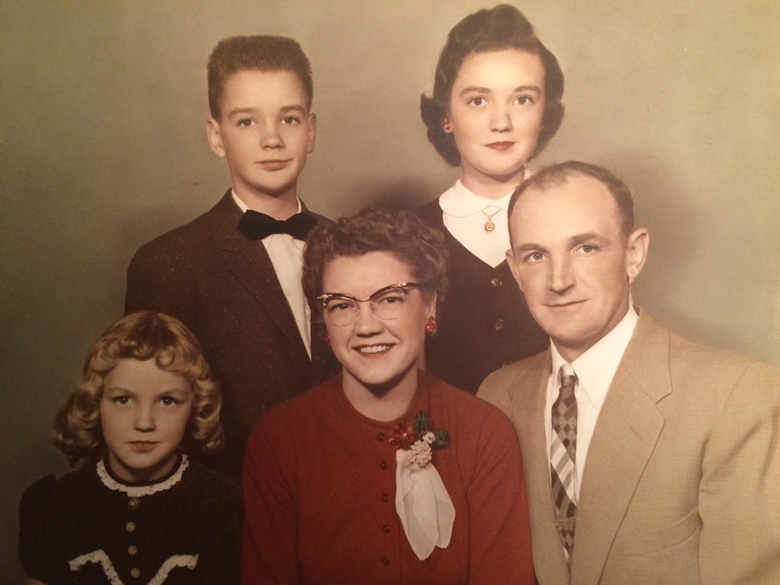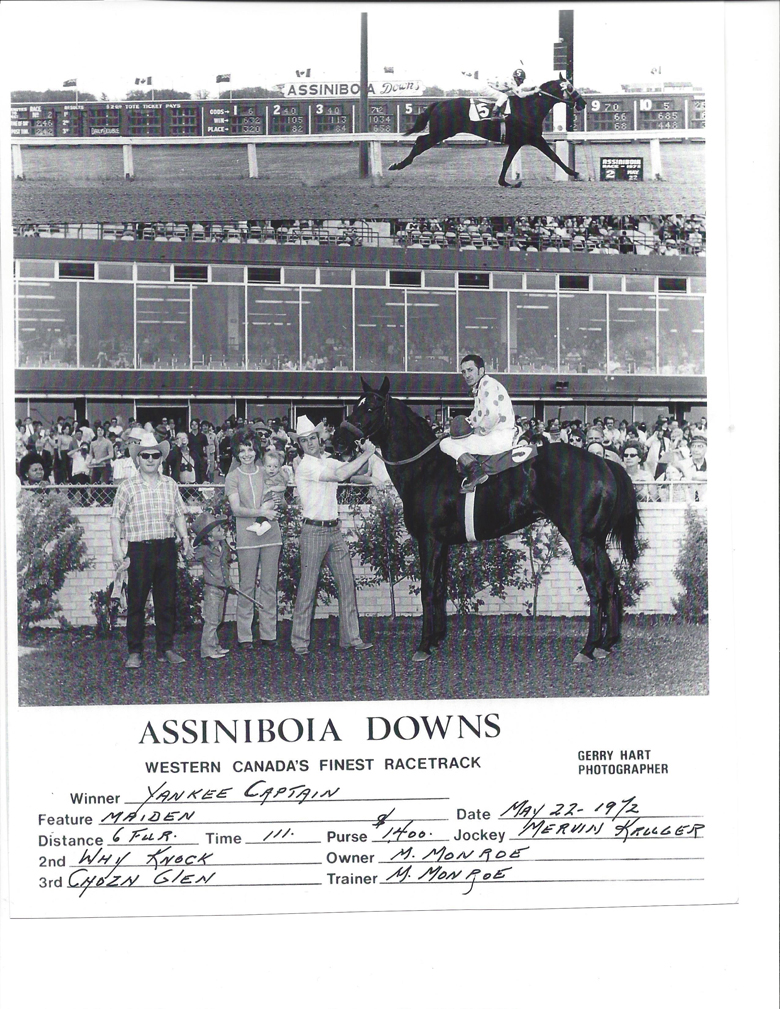
by Bob Gates
I’ve been writing this blog for going on six years and for the most part the stories have concentrated on local horsemen and their thoroughbreds. The Downs wouldn’t have survived all these years, however, if it were not for the “out-of-towners.”
For years horse people from other parts of Canada and south of the 49th parallel have travelled far and wide to race at Assiniboia Downs. This week we look at the contributions of one of these out-of-towners, the Monroe family from Radium, Minnesota.
In the beginning Monroe Stables consisted of George Monroe and his young son, Milo. They raced at the Downs from 1959 to 1983 and from 1993 to 1996.

George Monroe Family (1956) L-R, youngest daughter Jill, son Milo, wife Eva, eldest daughter Kay and George.
The Monroe horse racing adventure started in local county fairs in North Dakota and Minnesota. A county fair in Hallock led George and Milo to a chance meeting with the Gray brothers, Don and Clayton. A quick glance at a 1957 Marshall County Fair race program, which was basically a typed sheet of plain paper, reveals some familiar names: jockeys Milo Monroe and brothers Gary and Bobby Stewart, along with owner Bob Byfuglien (great uncle of Winnipeg Jet Dustin Byfuglien).
George and 15-year-old Milo made their debut at the Downs in 1959 and Cameo Queen gave them their first win on July 2, 1959. Milo wasted no time getting into the business of training thoroughbreds. After graduating from high school in Warren, Minnesota in June 1961 he left for Assiniboia Downs and I’m told got his trainers licence at 17. For the next two decades father and son were a team and George remained active in the racing business at the Downs until 1983.
The Monroes always had a modest size stable, never having more than 10 thoroughbreds in their barn at any one time. In the early days, Cameo Queen helped pay the bills. In the 1960s it was Tarry News, Drifting Flirt and Munnie Bridge. The 1970s saw horses like Thistle Bridge, Tishy Rae, My Third Boy, Munnie Cordona, Oscars Trend, Old Melon, Yankee Captain and the best horse the family ever owned, Munnie Award, take over. More on Munnie in a bit.

Yankee Captain. May 22, 1972. Milo holding horse, wife Lois on the left holding son Trevor, with other young son Todd further left.
In addition to racing at about a dozen or so tracks in Canada and the US, Milo trained at the Downs for 15 years. The Minnesota native was a humble, soft-spoken, straight-shooter kind of guy who prided himself on traditional family values and morals.
Milo’s wife Lois was an integral part of Monroe Stables. Lois walked many horses and sewed the yellow and red racing silks and blinkers for the family of thoroughbreds over the years.
In the mid-1970s it was time for the 30-year-old Milo to take over the 1100-acre family farm from father George. Milo now had demands on his time that would not allow him to do much training. He turned to an old pal, Don Gray, who trained the stable until 1984, when Milo took a break from racing to concentrate on raising a family and looking after the farm.
Milo always had a passion for thoroughbred horse racing. He returned to the sport he loved in 1993, again relying on Don Gray to train for the 1993 season with Lorna Gray taking over after Don’s death. Milo’s official retirement from racing came following the 1996 season.
Who knew?
Milo bred and raised Traffic Sub, who was a thoroughbred bust of a runner in 1972. This boy was so bad that couldn’t find the winner’s circle with a GPS, so Milo sold him to Bill Teske for $400. Teske renamed him Branch County and made a jumper out of him. Let’s just say the name and career change worked for Teske and Branch County, but not so much for Milo and Traffic Sub. The successful career change saw Branch County’s value soar to $80,000. At the Montreal Olympics in 1976 Branch County and rider Michel Vaillancourt won a Silver Medal for Canada, but that’s a story for another day!
Munnie Award, the best horse the family ever owned, was owned by George Monroe and trained by Milo. The multiple stakes winning chestnut was a big gelding that stood 17.3 hands tall, but he was quiet for his size.
So how does an American end up with a star Manitoba-bred? Well, George and Milo were impressed with the stakes schedule offered to Manitoba foals, so they shipped their mare Munnie Doll to Dr. Norm Anderson’s stud Oscar Award, and Pinehurst Farm became the birthplace of the resulting foal, Munnie Award.

1972 HBPA award winners. – L to R, Dr. Norm Anderson, Bob Anderson & Milo Monroe.
In 1972 Munnie Award won his first four career starts. After breaking his maiden and winning an allowance race, Munnie Award made his presence known in the premier stake races for Manitoba-bred 2-year-olds. He won the Fleur-de-Lis and the Buffalo Stakes. He followed up with second-place finishes in the Osiris Plate and Winnipeg Futurity.
I caught up with his regular rider, Bernie Howland the other day and he remembered Munnie very well. I guess you never forget the real good ones. Howland, who now calls the Interlake area home, described the chestnut gelding as a very large two-year-old with talent to burn.
In the prestigious Winnipeg Futurity, Munnie Award defeated some highly regarded eastern invaders. He finished second to Queen’s Splendor and third place finisher Zaca Spirit, went on to win the 1973 Manitoba Derby.
Speaking of his 2-year-old season, the purse money he earned in the Futurity raised his earnings to around $15,000, causing the Winnipeg Free Press to declare Munnie Award one of the richest 2-year-olds in Canada.
In his 3-year-old season, Munnie Award ran into some injury issues, but still managed to win the J. W. Sifton, place second in the Manitoba Stakes and third in the Manitoba Derby prep, the St. James-Assiniboia Handicap. In the Derby prep he finished third behind Wing Span and Queen’s Plate winner, Royal Chocolate and ahead of Merging Fire and Tara Road who also ran in the 1973 Manitoba Derby.
On the morning of the Sifton, Munnie Award was in ice boots in preparation for the race, but he grew tired of waiting for the race. Munnie decided it was time to stretch his legs. The next thing you knew, he was loose in the shedrow. Thanks to some quick thinking by fellow horseman John Cizik, Munnie was caught before doing any serious damage to himself and went out and won the Sifton that afternoon.
Milo was proud of Munnie Award’s accomplishments and said, “He provided our family with a lot of great memories at Assiniboia Downs.” Milo lost the big guy in a $10,000 claiming race at Greenwood in 1976 and was forever parted from his long-time friend.
In 1973 Milo made the newspaper headlines after he had failed to keep Munnie Award eligible for the Manitoba Derby, “Monroe let his Payments Lapse.”
While explanations were given and thoughts turned to what ifs, the truth of the matter was that Munnie Award’s size was working against him and he was just plain sore. Monroe would have liked a shot at the Manitoba Derby, but he knew deep down that Munnie would not have performed anywhere near his best. A Derby dream dashed.
George’s wife Eva passed in 1995 and the family buried patriarch, George in 2001. On their headstone is an engraved photo of Bobby Stewart aboard Munnie Award. Three months prior to his passing, George Monroe made one final trip north to the Downs, where he reminisced about the good old days and visited with old friends.
This past January Milo and Lois celebrated their 50th wedding anniversary. Why would someone get married in the dead of a Minnesota winter? To accommodate the horse racing schedule, of course!

Cameo Queen. July 2, 1959. Monroe Stables first win. On far left is George and son Milo.
Milo’s son, Trevor has become the family horse racing historian and archivist of Monroe racing memorabilia. Trevor has great interest and respect for his father’s racing past. This has been a stroke of good fortune, as Trevor and I have struck up a friendship that allows me to call upon him for assistance when it comes to seeking out other out-of-towners from Minnesota and the surrounding area. Trevor, my “go-to guy” in Minnesota, has an unbridled enthusiasm for the sport, so you know the Monroe family racing history is in good hands.
The Monroes won at the Downs in five different decades from the 1950s into the 1990s. Monroe Stables hasn’t raced horses here in a while, but trips to Assiniboia Downs are still important to the family. From George to Milo and now from Milo to Trevor, the torch has been passed.
It was only fitting that Milo’s final race at the Downs came on September 29, 1996. It was his youngest son Trevor’s birthday, and his horse Main Goose made sure it would be special.
They left the Downs as winners.
